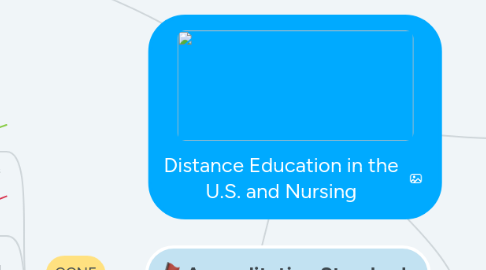
1. NLN CNEA
1.1. Distance learning programs are held to the same curricular, teaching/learning, and evaluation standards as campus-based programs (NLN CNEA, 2016).
1.2. Standards are written with Quality Indicators, Interpretive Guidelines, and Supporting Evidence criteria that must be met by the institution.
1.3. Standards are focused around the core values of caring, diversity, integrity and excellence in order to foster quality nursing education in the accreditation process.
1.4. Provides accreditation to all levels of nursing programs, including LPN and ADN.
1.5. Evaluation of technology use, grading policies, faculty/student ratios, and access to student services are especially considered in regards to distance education.
2. Accreditation Standards
2.1. CCNE
2.1.1. Distance education programs are held to the same accreditation standards as all other nursing programs.
2.1.2. Standards are written as broad statements that embrace several areas of expected institutional performance and related to each standard is a series of key elements that must be met (CCNE, 2018).
2.1.3. Standards explore program quality, mission, curriculum, teaching/learning practices, program effectiveness, and achievement of outcomes.
2.1.4. Provides accreditation only to Baccalaureate level programs and above.
2.1.5. Student participation, availability of academic support services, teaching/learning experiences, and availability of clinical practice are especially considered in regards to distance education.
3. Influence on Nursing Education and Staff Development
3.1. Positive
3.1.1. Online courses help meet demand, address classroom space shortages, provide for scheduling flexibility, and provide extra sections.
3.1.2. People all over the globe have the same access to quality nursing education through distance learning.
3.1.3. Use of online learning decreases cost for providing nursing and staff development education.
3.1.4. Students may work and go to school simultaneously.
3.2. Negative
3.2.1. Many faculty do not accept the value/legitimacy of online learning and do not want to be involved in helping it grow.
3.2.2. Less opportunity for face to face communication skills, which are essential in nursing practice and staff development
3.2.3. Higher instances of academic fraud may be present with distance learning courses.
3.3. Evidence-Base Development
3.3.1. Nursing distance learning programs are held to the same standards as face to face programs, thus student success outcomes are similar.
3.3.2. Use of interactive technology and quizzes in online staff education provides positive workplace outcomes and allows flexibility in completion to keep nurses in staffing.
3.4. Need for Resources
3.4.1. Enrollment in online educational courses is consistently growing, indicating a greater need for online educators (85% of public school students are enrolled in at least one online course).
3.4.2. Online learning creates a greater need for technological resources that may not have been used in face to face courses.
4. Terms & Definitions
4.1. Distance Education
4.1.1. Uses one or more technologies to provide education to students who are separated from the instructor. Federal Regulators and regional/program accrediting bodies all share this definition.
4.1.2. May use multiple means, such as: internet, one-way and two-way transmissions, videos, and CD's.
4.2. Online Education
4.2.1. Electronically supported education that relies on the Internet for teacher/student interaction and learning.
4.2.2. Uses only internet.
4.3. Correspondence Course
4.3.1. A educational class that is carried out through distance learning, whether that is online or with print materials that are transferred back and forth.
4.3.2. May use multiple means, such as: internet, print materials, and textbooks.
4.3.3. Student/Instructor interaction is limited and usually initiated by student as courses are typically self-paced (SACS, 2017).
